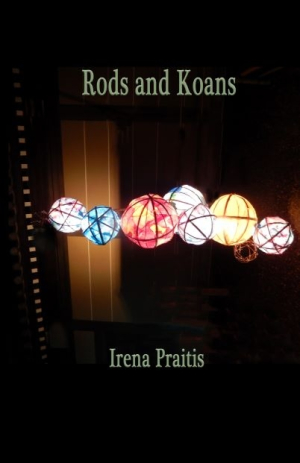Rods and Koans
In Rods and Koans, all matter becomes something that matters—the confluence exacting and broad.
Irena Praitis’s Rods and Koans begins with the enigmatic inscription, “This is about saving the cat … or not.” Borrowing the koan’s dialogic narrative and bending it into a new form, Praitis’s poetics shine with the same sensibility as zazen: the strict formal control of repetitive gesture practiced in a way that’s, paradoxically, freeing. From strophe to strophe, each poem shifts modes and perspectives to illuminate underlying connections and concerns.
There’s a wild complexity in Praitis’s form. The title sets the theme, the strophes present a series of interlinked responses, and a short quote that shifts the ideas in unexpected ways provides closure. Within any individual poem, this interlinking is fascinating, but the volume’s forty-eight poems are also linked. A word, topic, or idea mentioned in the final strophes of one poem becomes the title and focus for the next.
Praitis’s formal constraints are grandly technical, but they assert themselves subtly in the reading. The genius of these poems is not an enlightened one offering illumination, but that of someone who can’t help but notice the electric consanguinity between things. Thus, the poem “Latin≥Semitic≥Phoenician≥Greek≈English” can ask if you’ve
ever spent the afternoon picking hair from the
vacuum’s roller brush? Or, maybe you stand at the
sink and floss until your gums bleed, trying to save your
teeth? How about picking out of the carpet tiny pieces
from an over turned 2,000 plus Lego collection, or
stepping on said pieces first thing in the morning and
trying not to let your cursing wake the house? You
need the right kind of mind to know this is the work of
love. But who has that kind of mind?
and segue into a quote from Dr. Ralph Bunche, the mediator who established the Arab-Israeli War’s armistice lines.
The fluidity of Praitis’s transitions belies the complexity of the questions she asks, the answers those questions offer, and the world she observes. There’s often a sting embedded in the poem: a “rod” poised to wake up the inattentive. Section II opens with a first-person speaker driving across the desert reflecting on a night’s work “hitting targets on the other side of the world.” The speaker’s strophe ends without escape from “the pointed / accusations of that ball of fire mounting the horizon,” and the final strophe delivers commentary in the voice of Nikola Tesla: “If your hate could be turned into electricity, it would / light up the whole world.”
Repeating ideas and words run through the collection, interlocked as a crossword puzzle. “Montgomery, Alabama, December 1, 1955” translates a former passage about black women refusing to relinquish their bus seats into a lyric meditation: “Remaining steadfast— / a barycenter, a hinge / uniting chapters / of the story—requires / iron discipline.” When the image of the hinge appears in a later poem, “Ananke,” suddenly those black women are there, too. Considering the depth and breadth of Praitis’s subject matter, this tight whorl of language and imagery is surprising and grounding.
In this collection, science, philosophy, literature, art, history, and personal experiences are all fair game, offering both subject matters and shifting paradigms for poetic interrogation. Praitis’s bold fusion of what seems disparate points to a cardinal lineage between all things. Whether through interdependence, interconnection, or simple coexistence, in Rods and Koans, all matter becomes something that matters—the confluence exacting and broad.
Reviewed by
Letitia Montgomery-Rodgers
Disclosure: This article is not an endorsement, but a review. The publisher of this book provided free copies of the book and paid a small fee to have their book reviewed by a professional reviewer. Foreword Reviews and Clarion Reviews make no guarantee that the publisher will receive a positive review. Foreword Magazine, Inc. is disclosing this in accordance with the Federal Trade Commission’s 16 CFR, Part 255.

